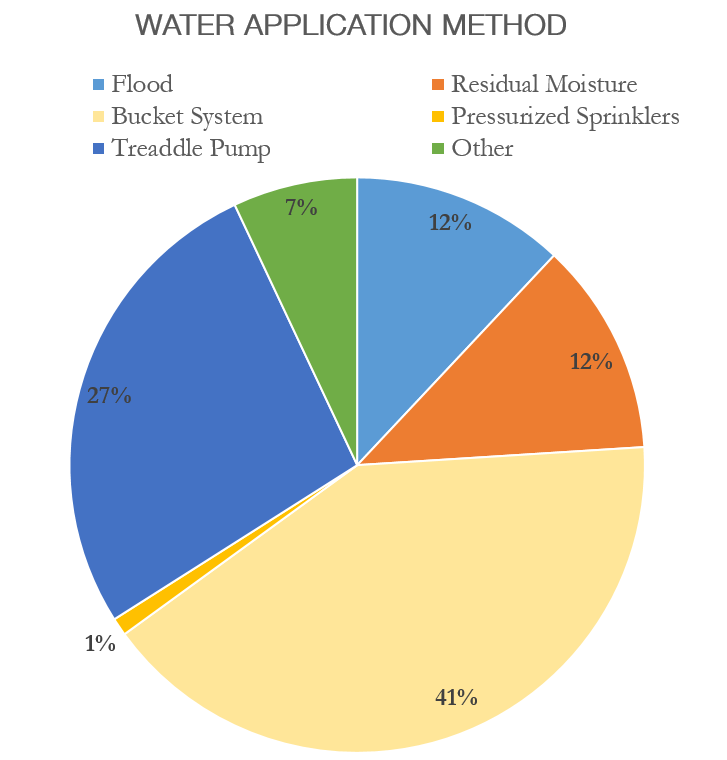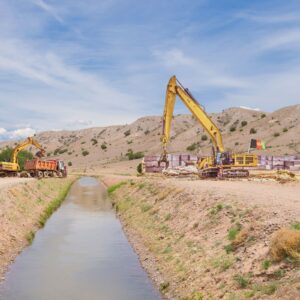Background
Climate change has been one of the hottest topics, and probably one of the most complex and challenging environmental issues, of recent decades. Governmental agencies, international organizations, and civil societies have come together to set agendas to tackle this complex challenge. Private companies and venture capital firms have taken advantage of the challenge and invested in the field of environmental finance. For the agricultural sector, climate change presents numerous challenges as well as opportunities for growth. Farmers are increasingly shifting toward smart farming and precision farming practices, and toward crops more adaptable to changing climates. While prioritizing adaptation is one agricultural response, another is trying to minimize the negative consequences of the changing climate. Hence, resilience has become an emerging area of interest for INGOs which are conducting interventions to help identify and promote best coping practices shared by smallholder farmer communities.
 |
 |
Stress on water availability negatively affects smallholders and crop productivity
There can be no doubt that droughts and floods comprise the biggest threat ever recorded to the livelihoods of smallholder farmers around the globe. The stress on water availability that has been induced by climate causes smallholders’ crop productivity to decline. Evidence from case studies, organizations’ publications, and academic research suggests that increased droughts and floods may consequently be exacerbating poverty levels, leaving many rural farmers trapped in a cycle of poverty and vulnerability. Further, according to my own experience over this summer in one of the least developed countries in Southern Africa, I found myself shocked by the severity of the impact caused by climate change. I conducted a research in Nsanje district of Malawi as part of an effort to evaluate a program intervention and to understand vulnerable populations’ experiences in adapting to climate change.
I learned that most of the farmers in this region rely on rain-fed subsistence farming to survive: about 41% of farmers use buckets to fetch water from far away places, and 24% of farmers are using residual moisture and floods to grow crops. The small-scale farmers I interviewed are aware that they are facing the brunt of global climate change’s adverse effects on agricultural productivity. Changing rainfall patterns and higher temperatures, floods and prolonged dry spells have forced these farmers to shorten their growing season. The increased frequency and intensity of floods and droughts have destroyed and eroded assets, causing a drastic increase in hunger and food insecurity in sub-Saharan Africa. Based on present trends, the current African food production system will be able to meet only 13% of the continent’s needs by 2050: African crop yields have been largely stagnant over the past 50 years, and less than 4% of the farmland in sub-Saharan Africa is irrigated. The limited irrigation is a particular problem in this context because the farmers I interviewed are seeing the consequences of this situation as climate change has exacerbated water-related problems.
Farmers left with no time to recover from previous disasters
Small farmers are hit the most by changes in the climate. One reason the crops of smallholder farmers are disproportionately devastated by changes in the climate is that, as climate-related disasters become more and more frequent, these farmers are often left minimal time to re-accumulate assets or acquire the skills and knowledge necessary to adapt their practice. It also takes time for humanitarian organizations to respond by distributing seeds and other agricultural inputs, as well as providing training on the use of new agricultural assets. Consequently, smallholder farmers are increasingly subject to continuous hunger, and farmers who were already vulnerable before the effects of climate change became so pronounced are suffering deeper cycles of poverty and vulnerability.
As mentioned above, agricultural responses to climate change have included several adaptation strategies like changes to crops grown and changes in growing patterns, but smallholder farmers often lack the capacity to adapt their practices in these ways. Awareness, knowledge, skills, technology and capital are the limitations. Without treadle pumps for example, people have to travel longer distances to fetch water and also due to lack of irrigation, people spend most of the time looking for off-farm work instead of working in their own fields. The United Nations Development Fund for Women estimates that women and children in Africa alone spend approximately 40 billion hours every year fetching and carrying water—the equivalent of a year’s labor for the entire workforce of France.
Coping with water scarcity before adapting agriculture to climate change
Irrigation has always been a constant constraint to agriculture development in the Southern Africa continent; consequently, many development organizations intervene in the disaster prone communities, distributing food to the most vulnerable households when disastrous droughts affect millions in the region. Few irrigation interventions take a more continuous approach and most of these organizations intervene in the aftermath of individual catastrophes, while few interventions are focused on longer-term/permanent infrastructural changes. Why don’t these organizations work together with the government to build irrigation projects and reservoirs? I asked the same question to field officers I encountered during my time in the region. In fact, they thought necessary infrastructures like irrigation projects and reservoirs built by the government or non-governmental agencies would help them sustainably developing their agriculture. The effected interventions seem to primarily reflect the priorities and interests of agencies and donors. On the aggregate, there appears to be a sentiment that farmers have no power to influence or choose specific interventions they want, given that they don’t have recourse to express preferences and also don’t want to resist these interventions with seeds, food, and trainings provided. In the near future, climate change will remain unpredictable and will only exacerbate the issue of water scarcity in the continent.
Analyzing the situation in northern Nigeria, Mortimore and Adams[1] mentioned five major elements of adaptation which are important implications for adaptive farming practice for most of the vulnerable regions in Southern Africa.
- Allocating farm labor across the season in ways that follow unpredictable intra-season rainfall variations, a technique known as “negotiating the rain”;
- Making use of biodiversity in cultivated crops and wild plants;
- Increasing integration of livestock into farming systems, even with the cost of increased labor demands;
- Working land harder, in terms of labor input per hectare, without increasing external non-labor inputs;
- Diversifying livelihoods.
Specifically, those farmers who own productive assets could diversify their agriculture inputs: this might involve exploring drought-tolerant plants to offset water shortages, or waterproofing crops to survive floods. For those vulnerable households who don’t own many assets but wait for humanitarian agencies’ assistance after individual catastrophes, organizations could encourage this kind of diversification by providing drought- and flood-tolerant seeds. While to cope with water scarcity, learning to implement the above five practices is one way. Growing crops during the dry seasons is still necessary for most farmers, government agencies and development organizations can advocate for best practices of exploiting traditional knowledge in dry season cropping.
The most proactive and adaptive way to meet with Africans’ urgent needs
There are a lot of interventions going on in terms of food distribution, seeds donation, and provision of agricultural inputs and trainings. There are also water projects and irrigation interventions. When there are treadle pumps, dams and reservoirs available to save rain and floods during rainy seasons, farmers benefit from them giving out water during dry seasons and don’t have to worry about droughts. Irrigation can facilitate important shifts in smallholders’ agricultural production and income generation: it not only enables a second cropping season, but the readier availability of water also enables farmers to cultivate nutritious, higher-value and profitability crops that require more reliable hydration. The problem is the scale of the irrigation projects.

Debates are going over whether building large dams is a better idea in Africa. However, based on my own observations, smallholders in rural Africa are really spread out and thus I think Africa is more suited to approaches that don’t operate the way damming does. Dams are a top-down intervention and involves large stakeholders’ interests. Energy activists in Africa are pushing for energy options that best meet the pressing needs of rural Southern Africa lack of water accessibility by meeting three criteria: reducing the energy poverty of the African poor; building countries’ resilience in the face of climate change; and transparently planning with public engagement. Large hydropower damming has failed to meet any of these criteria. Though dams generate electricity, there are concerns that dams’ power would be unevenly distributed and very little of them will provide for city- or village-level power to smallholders. So far there are no strategies that would facilitate the poor communities having sufficient and equitable access to the electricity. Hence, the development of decentralized power generation from either distributed irrigation projects, or renewable energy and small power plants will build the local economy in a bottom-up approach.
Distributed irrigation as a development priority in sub-Saharan Africa
According to the International Food Policy Research Institute (2010) , Africa’s average investment return rates (IRRs) for small-scale irrigation (28%) are much larger than those for large-scale, dam-based irrigation (7%). The report further indicates that the higher IRRs associated with small-scale irrigation are due to the generally much larger and higher-potential rain-fed areas located away from large-scale projects that could be profitably converted to small-scale irrigation. These small-scale irrigation projects also offer substantial environmental benefits over large centralized systems. Although the report suggests that farmers should make private investments in their own farms, most vulnerable farmers in the disaster prone region can not afford such installations because of their low monthly income. Hence, it’s local government capacity to alleviate the challenges smallholder farmers face in getting access to irrigation and adapting to climate change. However, I rarely saw any large, dam-based projects being done in Nsanje, Malawi where I spent my last summer, nor did I see or was informed of any small-scale irrigation projects and investments occurring there.
 Encouraging diverse crop variety farming, promoting small-scale distributed irrigation, and providing institutional support are most effective to help smallholders prepare to cope with future climatic conditions. In regions where rainfall is erratic and unpredictable and it is projected to have more droughts in the future, distributed irrigation and small water impounding are recommended options. However, unless something specific is done, irrigating Africa would continue to be a constant constraint to African agriculture development and smallholders’ adaptation to climate change. Targeted investments and favorable policies to expand distributed irrigation projects in rural areas would ease the constant constraint.
Encouraging diverse crop variety farming, promoting small-scale distributed irrigation, and providing institutional support are most effective to help smallholders prepare to cope with future climatic conditions. In regions where rainfall is erratic and unpredictable and it is projected to have more droughts in the future, distributed irrigation and small water impounding are recommended options. However, unless something specific is done, irrigating Africa would continue to be a constant constraint to African agriculture development and smallholders’ adaptation to climate change. Targeted investments and favorable policies to expand distributed irrigation projects in rural areas would ease the constant constraint.
Endnotes
- Mortimore MJ and Adams WM (2001). Global Environ Change 11:49-57 ↑





